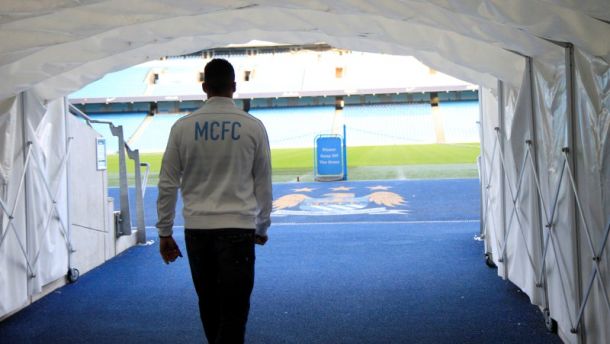In a relatively surprising move on deadline day, Alvaro Negredo completed a one year loan deal to Valencia. Seeing as the deal includes an obligation for Valencia to buy the player at the end of the loan, it appears to be the end of "The Beast's" short stay at the Etihad.
Whether he was homesick, or his wife was unhappy in England, Negredo never truly settled in Manchester. A brilliant start to last season is likely to have helped him feel at home, but following that electric adaptation to English football, Negredo's fortunes turned for the worse. The Spaniard suffered a shoulder injury, subsequently losing all form, and just when he seemed to be recovering in pre-season, he broke a bone in his foot. Even his closest friend at the Etihad - Javi Garcia - has left for Russia. Considering his family was unsettled, it is no surprise that this horrible run of luck swayed Negredo into considering a move back to Spain and La Liga.
With the move to Valencia official, we take a look at what it means to Pellegrini's plans.
Is three strikers enough?
In practically all of Manuel Pellegrini's matches in charge at Manchester City, he has opted to play two players "up front". The Chilean is a firm believer in occupying both of the opposition centre backs and will often sacrifice numerical advantage in midfield in order to stick to this philosophy. With that in mind, is it a wise decision to let Negredo leave with rotation key in the modern game and a tough schedule ahead? Most notably, following the international break, Manchester City play Arsenal away, FC Bayern away, and Chelsea at home, all in the same week. Negredo would likely not have returned from injury by that run of games, but it highlights the crushing need for as many quality players as possible in the squad.
Analysing the strike-force at face value, Manchester City have three players to fit two positions. More in depth analysis would take into account that Manuel Pellegrini seems to prefer the standard strength-speed partnerships. The most common partnerships last season were Negredo-Aguero and Dzeko-Aguero. Only when both Aguero and Jovetic were injured was Pellegrini forced to play Dzeko-Negredo, which was clearly not ideal as he stopped once Aguero or Jovetic returned. With that in mind, it is likely that Dzeko will play a higher fraction of games than either Jovetic or Aguero as he will feature in the partnerships of Dzeko-Aguero or Dzeko-Jovetic which seem to be preferred over Aguero-Jovetic. Therefore, in terms of squad rotation, it seems Negredo's exit will have the biggest impact on Dzeko who might have to endure a Zabaleta-esque marathon of a season if Pellegrini is to use his ideal set up.
"Telephone Numbers"
"There's no such thing as a perfect system, and telephone numbers like 4-4-2, 4-2-2-2 aren't of importance"
Manuel Pellegrini
The general consensus amongst City fans and journalists seems to be that Negredo's departure signals that Pellegrini will increasingly use systems involving a lone striker. It is all dependent on what you mean by striker; Do you mean someone who's main job is to finish off the team moves and convert chances into goals? Or do you mean someone who is in the position of the 2 in the 4-4-2 regardless of what he gets up to in that position?
The thing is, as the above quote shows, Pellegini doesn't believe in numbered positioning systems. The main ideas of Pellegrini's system is to drill players into forming set patterns for specific scenarios: whether the ball is near the touchline, or Yaya is driving down the centre of the park, the team has pre-planned attacking movements designed to offer options and create spaces in the oppositions defense. Pellegrini doesn't just make sure the team knows their own roles, everyone on the team has to know the roles of everybody else. Not only does this mean that each player knows where the others are and will be, but following rotations, any player can play in any position - as highlighted by Dzeko playing left back and left midfield in the lead up to City's second goal against Liverpool in August.
This attacking fluidity has been the driving force behind Pellegrini's stubbornness regarding system changes. The system Pellegrini plays is the same for every single match. The difference lies in the players he selects for each position. If Navas plays in place of Nasri on the right wing, the team will enact attacking movements to create space on the touchline where Navas is most dangerous as opposed to the centre where Nasri prefers.
It is similar to analysing the difference in Zabaleta's movements when playing with either Navas or Nasri: With Nasri, Zabaleta will mainly attack the opposition box from a wide angle, overlapping the midfield and providing width. With Navas, Zabaleta waits for Navas to attack down the wing and then drives into the box more centrally in an underlap since Navas is already providing the width. In both scenarios, Zabaleta is obviously still a right-back, but his role in the team has changed significantly.
This is analogous to the "lone striker" system that City fans are crying out for. In the quoted examples of City playing a "5-man midfield" it has been widely recognized that Silva is the one who is moved to a more central position. This is not Silva taking up the AM slot in a 4-2-3-1 but rather Silva slotting in as "striker" in a 4-4-2. Since rotation would leave Silva in that position frequently anyway, he is comfortable playing there. The difference in the system comes when Silva does what Silva does best and drops into the hole to receive the ball and orchestrate play. Aguero and Jovetic both attempt this throughout games but the strikers usually rotate the role of dropping deep. When Silva is played up front he does it much more frequently then the other striker which leads people to say that Silva is playing as a fifth midfielder. It is clear, however, from the position he takes up defensively that Silva is indeed a second striker and not a midfielder.
This use of Silva - or Nasri - as a striker to drop and help out in midfield was used mainly in the big games or when Pellegrini decided to be more pragmatic, but now that there are only three recognized strikers, expect to see a lot more of it.
"Two in every Position"
The final effect of Negredo's departure is seen in Pellegrini's repeated insistence on having two quality players in every position. Not only is it vital for rotation purposes, but it gives Pellegrini versatility and it gives the squad healthy competition.
Who would disagree that the left back spot - arguably the best example of two in every position - is not one of the strongest it has ever been. Not only have Clichy and Kolorov been rotating regularly, but both have been striving to improve. At first Clichy was the first choice left back, but then Kolorov improved dramatically. Now, Clichy seems to be rediscovering his earlier form.
This situation means that not only has Pellegrini different approaches to choose from, but the squad depth forces both players to work hard to improve or else lose their place. This is arguably going to effect Dzeko. With Negredo gone and Pellegrini preferring the presence of a big striker up front, Dzeko's regular position in the starting line up is more secure. Will we see a less driven Dzeko as he has no one as main competition for his spot? Time will tell.










































